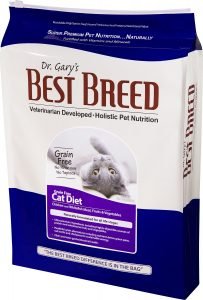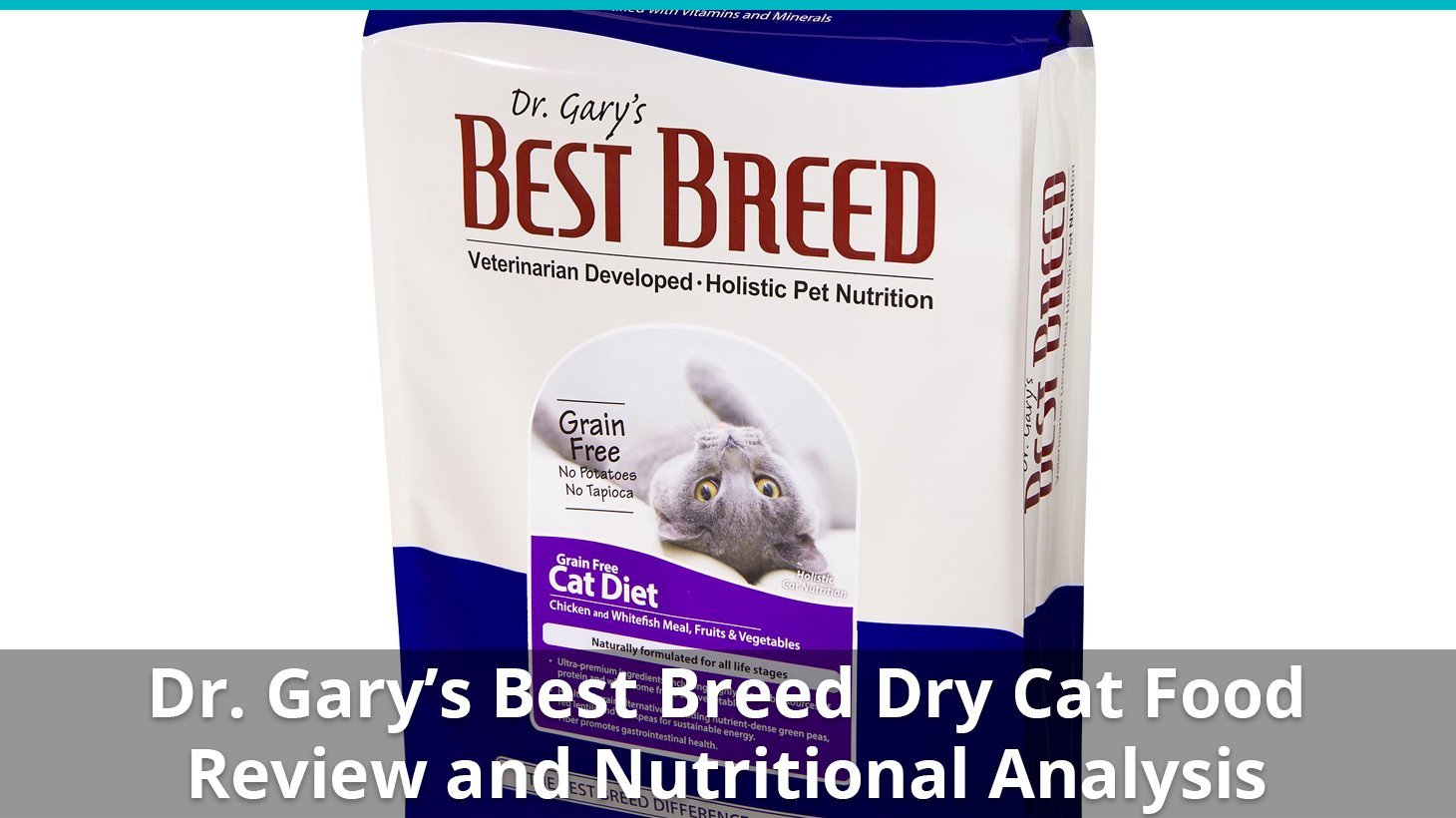Our review process is unbiased and based on extensive research. If you buy through the links on our site, we may earn a commission.
Rating
- Meat is the first ingredient – 1 Star
- Uses some unnamed meats – 1 Star
- Above average protein content – 0.5 Star
- Less than 4 controversial ingredients – 0 Star
- Catological Discretionary Rating – 0 Star
Here’s a few important points:
- Meat is the first ingredient
- There are a number of fillers used, which are not biologically appropriate for your cat
- The protein content is acceptable, but the carbohydrate content is too high for a healthy cat food
- Extra vitamins and quality, proteinate versions of some minerals are added
Dr. Gary’s Best Breed product line includes 2 dry recipes/flavors.
Each recipe below includes its related AAFCO nutrient profile when available on the product’s official webpage or packaging: Growth (G), Maintenance (M), All Life Stages (A), Supplemental (S) or Unspecified (U).
The star rating is a rough average of all of the flavors in a single line of food. If an individual recipe scored lower or higher, we will mark that below, next to the flavor.

Dr. Gary’s Best Breed Grain Free was selected to represent the other products in the line for this review.
Dr. Gary’s Best Breed Grain Free
Dry Cat Food
| Estimated Nutrient Content |
| Protein | Fat | Carbs | |
|---|---|---|---|
| Guaranteed Analysis | 38% | 17% | NA |
| Dry Matter Basis | 42% | 19% | 23% |
| Calorie Weighted Basis | 38% | 41% | 21% |
Estimated Dry Matter Nutrient Content
Fiber (guaranteed analysis)
7%
Calories/100g
440
Is real, named meat the first ingredient?
Yes
Ingredients
Chicken Meal, Egg Product, Chicken Fat (Preserved with Natural Mixed Tocopherols), Red Lentils, Chickpeas, Green Peas, Whitefish Meal, Dried Beet Pulp, Cellulose, Brewers Dried Yeast, Natural Chicken Flavor, Ground Flax Seed, Fish Oil, Cranberries, Blueberries, Lecithin, Kelp Meal, Salt, Potassium Chloride, Dl Methionine, L-Lysine, Taurine, Vitamin E Supplement, Niacin Supplement, Biotin, Thiamine Mononitrate, Pyridoxine Hydrochloride, Vitamin A Acetate, Riboflavin Supplement, D-Calcium Pantothenate, Vitamin B12 Supplement, Citric Acid, Vitamin D3 Supplement, Folic Acid, Potassium Chloride, Ferrous Sulfate, Zinc Sulfate, Zinc Proteinate, Iron Proteinate, Zinc Oxide, Copper Sulfate, Manganese Sulfate, Manganese Proteinate, Copper Proteinate, Manganous Oxide, Sodium Selenite, Calcium Iodate.
Ingredients in red are controversial or of questionable quality.
Ingredient Breakdown
The first ingredient in this cat food is chicken meal. Good.
Chicken is a very good protein source for cats.
Chicken meal is a concentrated form of chicken, and is considered a high quality ingredient.
In short, much of the moisture of the chicken is taken away, and you are left with a very high-protein, low-moisture powder-like substance.
The inclusion of chicken meal helps to ensure a very high protein level.
The second ingredient is egg product. Good.
Even though eggs are not meat, they are a highly digestible form of protein.
In fact, they are one of the most complete, bioavailable forms of protein for both humans and cats.
As long as it is not the main protein ingredient, the addition of egg is a quality ingredient
The third ingredient is chicken fat. Good.
Named animal fats in cat food is usually a good thing. Cats do need a fair amount of fat.
Chicken fat is a great source of healthy fats and omega fatty acids.
It is preferred to canola oil or unnamed animal fats.
The fourth ingredient is red lentils. Bad.
An obvious non-biologically appropriate carbohydrate filler, beans are at least potentially better than corn.
They are unlikely to do any damage to your cat.
However, some cats may have trouble digesting them.
They are also protein-rich, which means the actual meat content of this recipe may be lower than the macronutrient profile suggests.
They are usually used as a cheap protein source to cover up using only a little bit of meat in the recipe.
The fifth ingredient is chickpeas. Bad.
An obvious non-biologically appropriate carbohydrate filler, beans are at least potentially better than corn.
They are unlikely to do any damage to your cat.
However, some cats may have trouble digesting them.
They are also protein-rich, which means the actual meat content of this recipe may be lower than the macronutrient profile suggests.
The sixth ingredient is green peas. Bad.
Peas are a quality carbohydrate, but cats don’t need much in the way of carbohydrates.
They are full of fiber, but also contain a fair amount of protein, which we should keep in mind when judging the meat content of this food.
There probably aren’t many peas in here, but there really doesn’t need to be any.
The seventh ingredient is whitefish meal. OK, but with reservations.
“Whitefish” is a bit of a difficult term in the cat food industry, because it may mean any number of fish.
However, it seems that most whitefish labels mean tilefish, a small, commercially fished ingredient, that is high in protein and fat.
Fish are not often eaten in the wild by cats, and this particular fish may pose a high risk of mercury poisoning.
If this is, indeed, tilefish, the FDA has warned pregnant women not to consume it due to high mercury levels.
It is likely not present in high enough quantities to worry, but the risk remains.
A meal is a concentrated form of the ingredient after most moisture (including the healthy oils) are removed.
The eighth ingredient is dried beet pulp. OK, but with reservations.
Beet pulp is intended to increase fiber quantities in pet foods, and may be good for intestinal health.
However, some believe it is just an inexpensive filler.
Whatever the case, we believe that a little bit in the food isn’t detrimental to your cat, but probably isn’t a necessary ingredient.
The ninth ingredient is cellulose. Bad.
Cellulose is a filler high in insoluble fiber.
It’s typically wood pulp (sawdust) from pine trees.
Too much insoluble fiber can interfere with digestion and inhibit protein and nutrient uptake.
This recipe includes a number of other ingredients, but once you get down this far, none of them will be in large enough quantities to make a real difference, except for the added vitamins and minerals.
It uses brewer’s dried yeast, which is a by-product of brewing beer. It is used for flavoring and for protein and B-vitamins.
However, some reports suggest that it can become very toxic to the liver, causing allergies and arthritis, in large doses.
The minerals are presented in their proteinate form, which means they will be easier to digest and absorb, which is an indicator of quality.
To read a more in depth article about any of the ingredients listed here, check out our Cat Food Ingredient Wiki (currently under development).
The Catological Verdict on Dr. Gary’s Best Breed Wet Cat Food
From top to bottom, this is an average wet product.
Meat is the first ingredient, but there are a number of fillers in each recipe, which are not necessary, or even good, for your cat’s health.
It is fairly average, but the carb content is above average, which is not a good sign.
This is a not a good example of the type of food you should be feeding your cat if you choose to feed a dry diet.
Meat is the first ingredient, but there are other non-meat protein sources like beans and peas. That means there is likely less meat in there than you’d think by just looking at the protein content on the label.
It’s probably a split meat- and plant-based food, which is not entirely appropriate for your carnivorous cat.
To review, on a dry matter basis, this food is 42% protein, 19% fat, and 23% carbs.
As a group, the brand has an average protein content of 42%, and average fat content of 16%, and an average carb content of 26%.
Compared to the other 2000+ foods in our database, this food has:
- Average protein.
- Average fat.
- Above average carbs.
Because meat is the first ingredient, but unnecessary carbohydrate fillers are utilized, our rating for this brand is 2.5 stars.
Not recommended.
Dr. Gary’s Cat Food Recall History
We do not believe that a recall indicates a low quality food or company, and we respect the fact that sometimes things happen that cause a manufacturer to recall a food.
Usually these things are non-life-threatening, and we think it’s important to take a moment to be thankful about just how few recalls there really are in the industry, considering the enormous volume of food produced.
However, we do believe that a history of recalls may point to a larger issue with a company, and that discerning consumers want to know who they’re buying from, especially when it comes to something as important as the food you feed your beloved cat.
Here is a list of recalls that have affected the Dr. Gary’s brand in the past:
- We could find no instances of recalls in Dr. Gary’s history
If you want to stay up to date on the latest recall information affecting your cat’s food, sign up to our email list and receive an email every time a recall is announced. We’ll also let you know about any updated ratings, recipe changes, or new cat foods on the market. (Our alert system will be launched shortly, check back soon.)
Where To Buy Dr. Gary’s Dry Cat Food
We recommend purchasing your pet products from Chewy.com. They continually prove that they walk the walk while talking the talk, and I’ve never dealt with a more dedicated pet-parent base of people than those who work at Chewy.
Plus, they offer 20% off and free shipping on lots of orders.
Not convinced?
Check out our ratings and reviews of the best cat foods in our comprehensive, data-backed guide right here.

